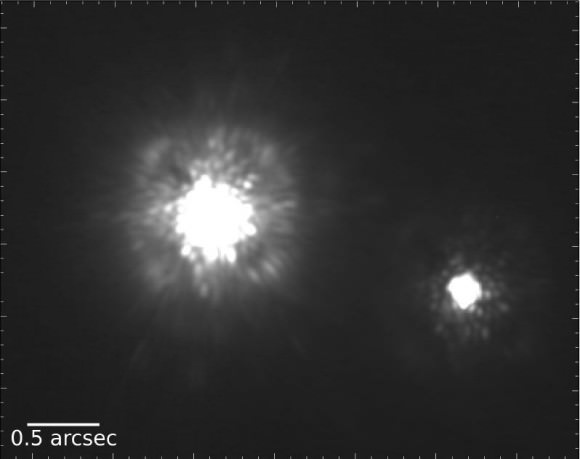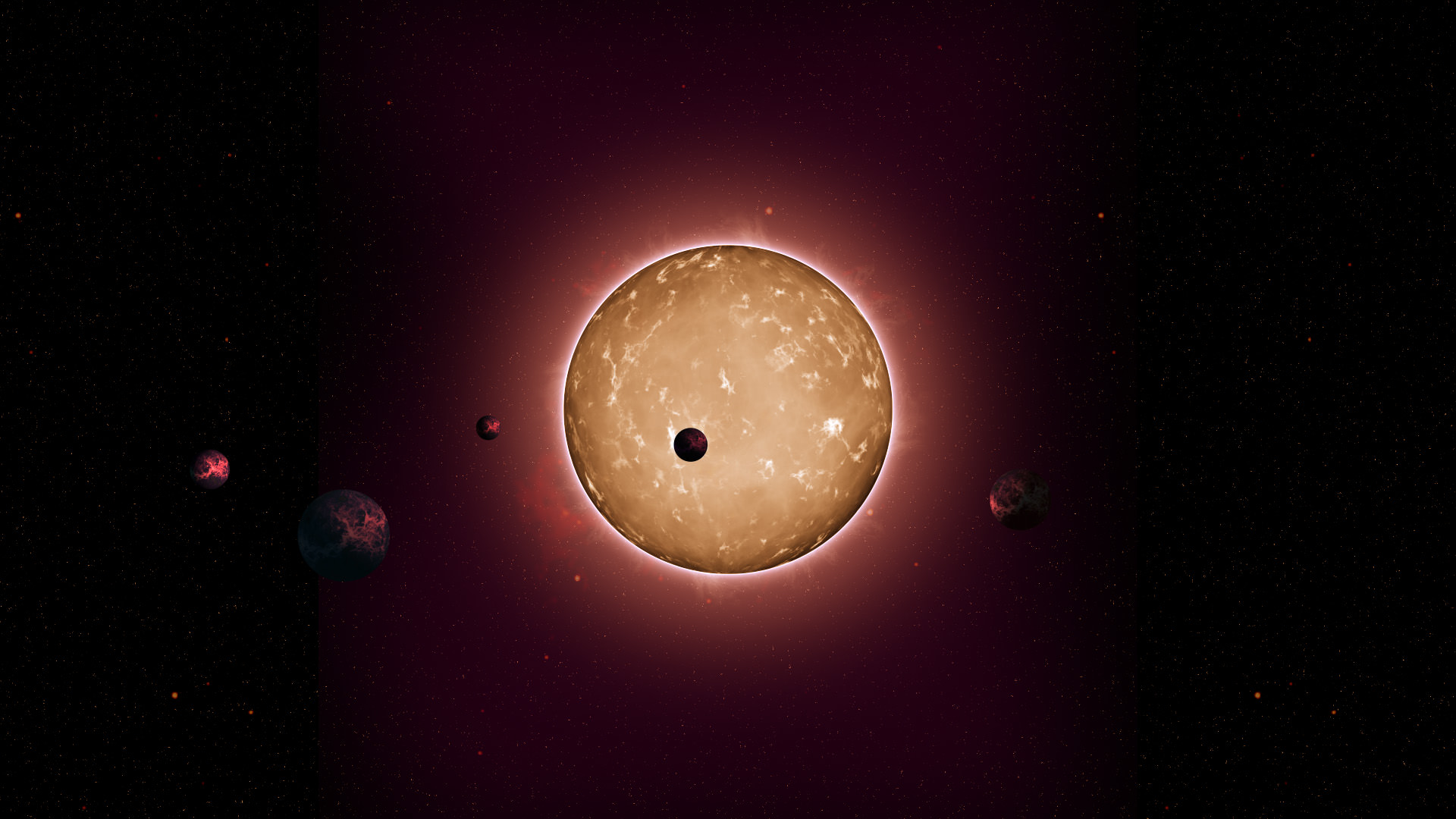Using data from the Kepler space telescope, an international group of astronomers has discovered the oldest known planetary system in the galaxy – an 11 billion-year-old system of five rocky planets that are all smaller than Earth. The team says this discovery suggests that Earth-size planets have formed throughout most of the Universe’s 13.8-billion-year history, increasing the possibility for the existence of ancient life – and potentially advanced intelligent life — in our galaxy.
“The fact that rocky planets were already forming in the galaxy 11 billion years ago suggests that habitable Earth-like planets have probably been around for a very long time, much longer than the age of our Solar System,” said Dr. Travis Metcalfe, Senior Research Scientist Space Science Institute, who was part of the team that used the unique method of asteroseismology to determine the age of the star.
The star, named Kepler-444, is about 25 percent smaller than our Sun and is 117 light-years from Earth. The system of five known planets is very compact, and all five planets orbit the parent star in less than 10 days, or within 0:08 AU, roughly one-fifth the size of Mercury’s orbit.
“The star is slightly cooler than the Sun (around 5000 K at the surface, compared to 5800 K),” Metcalfe told Universe Today, “but the planets in this system are still expected to be highly irradiated and inhospitable to life,” with little to no atmospheres.
The team wrote in their paper that the system’s habitable zone lies 0:47 AU from the parent star and so all planets orbit well interior to the inner edge of Kepler-444’s ‘Goldilocks zone.’
The team was led by Tiago Campante, a research fellow at the University of Birmingham in the UK.
The planets were found by analyzing four years of Kepler data, as the spacecraft had nearly continuous observations of Kepler-444 during Kepler’s active mission. The space telescope took high-precision measurements of changes in brightness in stars in its field of view. There are tiny changes in brightness when planets pass in front of their stars.
Transit signals indicated five planets orbiting Kepler-444, although this star has a binary companion, an M-dwarf, and it was a tedious process to tease out all the data to determine what were planets and not other stars, as well as which star the planets were orbiting.

Metcalfe said the the job of “validating” the planets by ruling out all of the other possible “false positive” scenarios is always a big challenge for Kepler targets.
But asteroseismology was used to directly measure the precise age of the star. Asteroseismology, or stellar seismology is basically listening to a star by measuring sound waves. The sound waves travel into the star and bring information back up to the surface. The waves cause oscillations that Kepler observes as a rapid flickering of the star’s brightness.
How can this help determine a star’s age?
“As a star ages, it converts hydrogen into helium in the core,” Metcalfe said via email. “This changes the mean density of the star over time, and asteroseismology provides a very precise measure of the mean density (from the regular spacing of the individual oscillation frequencies).”
Metcalfe said that in this case, the uncertainty on the age of the star (and thus the planets, which formed essentially at the same time) is only 9%, compared to a typical uncertainty of 30-50% from other methods based on rotation (gyrochronology) or other properties of the star.
The team also noted in their paper that this finding may also help to pinpoint the beginning of the era of planet formation.
“I think this system has a lot to teach us about planet formation and the long-term evolution of planetary systems,” said Darin Ragozzine, a professor at Florida Institute of Technology and a a member of the discovery team, who specializes in multi-transiting systems. “With an age of 11.2 billion years, it means that this system formed near the beginning of the age of the Universe.”
The team wrote that this finding implies that small, Earth-size, planets may have readily formed at early epochs in the Universe’s history, even when metals were more scarce.
“By the time Earth formed, this star and its planetary system were already older than our planet is today,” Ragozzine told Universe Today. “We don’t know for sure if this system has stayed the same the whole time, but it is amazing to think that the little inner planet has gone around the star about a trillion times!”
To find out more about asteroseismology, check out a website called the Pale Blue Dot Project. Metcalfe launched a non-profit organization to help raise research funds for the Kepler Asteroseismic Science Consortium. The Pale Blue Dot Project allows people to adopt a star to support asteroseismology, since there is no NASA funding for asteroseismology.
“Much of the expertise for this exists in Europe and not in the US, so as a cost saving measure NASA outsourced this particular research for the Kepler mission,” said Metcalfe, “and NASA can’t fund researchers in other countries.”
Metcalfe added that the “adopt a star” program supported the asteroseismic analysis of Kepler-444, “determining the precise age that makes this ancient planetary system so interesting… This private funding from citizens around the world has been an invaluable resource to facilitate our research and fuel amazing discoveries like this one.”
You can help this research by adopting one of the Kepler stars or planetary systems.
This research was published today in the Astrophysical Journal.
The team’s paper is titled, “An Ancient Extrasolar System with Five Sub-Earth-Size Planets.”


If life formed in this early Planetary System how advanced would they be now its mind blowing to imagine……
No way of knowing. Maybe they’ve ascended to a godlike state of being. But for all we know, life on these scorched planets might have stagnated at the single-cell stage for billions of years if it ever existed at all.
This discovery of rocky planets around old stars is not surprising for those following exoplanet discoveries closely. This is especially so after the discovery of a rocky planet around Kapteyn’s star. The evidence has been showing that older stars and low metallicity stars tend to be poor at forming gas giants, but seem to have had no problem forming terrestrial planets around them. Silicon is likely the predominant element in these planets and it is not a heavy metal and should be relatively abundant even in Population II stars as we are finding. Generally speaking it seems that it is relatively easy to form terrestrial planets like Earth, and as a consequence they should be quite abundant in the universe. The implications for our distant future, if we make it there, and for finding alien life are quite good.
What I would like to know is:what sort of elements needed to form “intelligent” life? We all know that, at the start, there was just H and He and a little bit of some heavier stuff. The rest of what makes us has to be cooked and spread by SNs… and that takes time!
What would be the earliest “production date” of life like us?
That there are planets there at all, tell us there’s a wide range of heavy elements available in that system, even if those particular planets are bad bets.
But you need a first generation of fairly massive stars to produce heavier elements, and supernova events to both spread them pack into the Universe, as well as to make anything heavier than iron-56, which is where the fusion train necessarily ends.
“The team says this discovery suggests that Earth-size planets have formed throughout most of the Universe’s 13.8-billion-year history, increasing the possibility for the existence of ancient life – and potentially advanced intelligent life — in our galaxy.”
“…there is no NASA funding for asteroseismology.”
How is it that both those sentences found their way into the same article? That’s as mind-boggling a fact as is the existence of an 11 Ga-old planetary system.